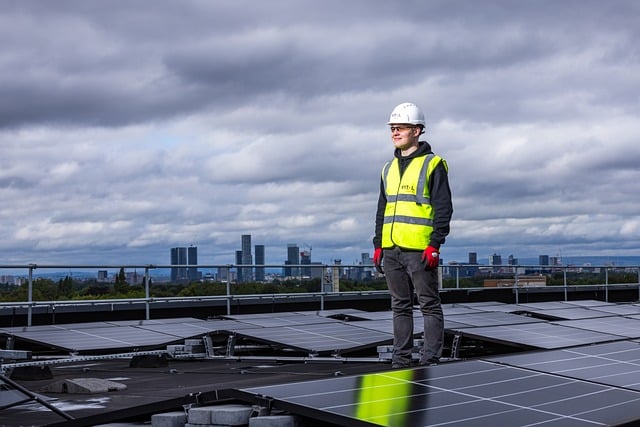“Master Your Solar Setup: Advanced Wiring Tips for Optimal Performance.”
When it comes to solar energy systems, advanced users often seek to optimize performance, efficiency, and safety through meticulous wiring practices. Proper solar wiring is crucial for maximizing energy output, minimizing losses, and ensuring the longevity of the system. This guide delves into essential tips for advanced users, covering topics such as wire sizing, connection techniques, grounding methods, and the importance of adhering to local electrical codes. By implementing these advanced wiring strategies, users can enhance their solar installations, ensuring reliable and effective energy generation.
Advanced Techniques for Solar Panel Wiring
For advanced users looking to optimize their solar panel systems, understanding the intricacies of solar wiring is essential. While basic wiring techniques are often sufficient for standard installations, advanced users can benefit from a deeper exploration of wiring configurations, component selection, and safety measures. One of the first considerations is the choice between series and parallel wiring. Series wiring increases voltage while maintaining the same current, making it ideal for long-distance runs where voltage drop can be a concern. Conversely, parallel wiring maintains voltage while increasing current, which can be advantageous when connecting multiple panels to a single inverter. Advanced users should carefully assess their system requirements and environmental conditions to determine the most effective configuration.
In addition to wiring configurations, the selection of appropriate wire gauge is crucial. The American Wire Gauge (AWG) system provides a standardized way to determine wire thickness, which directly impacts resistance and efficiency. For longer runs, it is advisable to use a thicker wire to minimize voltage drop. Advanced users should calculate the expected current and distance to ensure they select a wire gauge that meets the National Electrical Code (NEC) requirements while optimizing performance. Furthermore, using high-quality, UV-resistant cables can enhance the longevity of the installation, particularly in harsh weather conditions.
Moreover, advanced users should consider the integration of bypass diodes in their solar panel systems. Bypass diodes are essential for preventing power loss due to shading or panel malfunction. By allowing current to bypass shaded or damaged cells, these diodes help maintain overall system efficiency. When wiring panels in series, incorporating bypass diodes can significantly reduce the impact of shading, ensuring that the entire array continues to function effectively. Advanced users should familiarize themselves with the specifications of their solar panels to determine the optimal placement and configuration of these diodes.
In addition to these technical considerations, advanced users should also prioritize safety in their wiring practices. Proper grounding is a critical aspect of any solar installation, as it protects both the system and the user from electrical faults. Grounding should be implemented according to NEC guidelines, ensuring that all components are securely bonded to a common ground. Additionally, using circuit breakers and fuses can provide an extra layer of protection against overcurrent situations, which can lead to equipment damage or fire hazards. Advanced users should regularly inspect their systems for signs of wear or damage, as proactive maintenance can prevent costly repairs and enhance system reliability.
Furthermore, advanced users may explore the benefits of using smart wiring solutions, such as power optimizers or microinverters. These technologies allow for individual panel monitoring and optimization, which can significantly enhance overall system performance, especially in partially shaded environments. By integrating these advanced components, users can achieve greater energy yields and more efficient energy management.
Finally, as technology continues to evolve, staying informed about the latest advancements in solar wiring techniques is essential for advanced users. Engaging with online forums, attending workshops, and reading industry publications can provide valuable insights and updates on best practices. By continually refining their knowledge and skills, advanced users can ensure that their solar panel systems operate at peak efficiency, contributing to a more sustainable energy future.
Optimizing Wire Gauge for Solar Installations

When it comes to optimizing wire gauge for solar installations, advanced users must consider several critical factors that can significantly impact the efficiency and safety of their systems. The wire gauge, or thickness, plays a pivotal role in determining how much current can safely flow through the wires without overheating or causing voltage drops. Therefore, selecting the appropriate wire gauge is essential for maximizing the performance of solar panels and ensuring the longevity of the entire system.
To begin with, understanding the relationship between wire gauge and current capacity is fundamental. The American Wire Gauge (AWG) system is commonly used to specify wire sizes, with lower numbers indicating thicker wires. Thicker wires can carry more current, which is particularly important in solar installations where the output can vary based on sunlight conditions. For instance, if a solar panel system is designed to produce a significant amount of power, using a wire gauge that is too small can lead to overheating and potential damage. Consequently, advanced users should always refer to the National Electrical Code (NEC) guidelines, which provide detailed tables for determining the appropriate wire gauge based on the expected current load.
Moreover, voltage drop is another critical consideration when optimizing wire gauge. As electricity travels through a wire, some energy is lost as heat, leading to a reduction in voltage by the time it reaches the inverter or battery bank. This voltage drop can be particularly pronounced in longer runs of wire, which is often the case in larger solar installations. To mitigate this issue, advanced users should calculate the expected voltage drop and select a wire gauge that minimizes this loss. A general rule of thumb is to aim for a voltage drop of no more than 3% for the entire circuit. By doing so, users can ensure that their solar system operates efficiently and that the energy produced is effectively utilized.
In addition to current capacity and voltage drop, environmental factors must also be taken into account when selecting wire gauge. For example, wires exposed to extreme temperatures or harsh weather conditions may require thicker gauges to maintain performance and safety. Furthermore, the type of insulation used on the wire can influence its ability to withstand environmental stressors. Advanced users should opt for wires with high-quality insulation rated for outdoor use, as this will enhance durability and reduce the risk of failure over time.
Another important aspect to consider is the type of connection points within the solar installation. Junction boxes, connectors, and terminals can all introduce resistance into the system, which can further exacerbate voltage drop issues. Therefore, it is advisable to use connectors that are compatible with the selected wire gauge and to ensure that all connections are secure and properly insulated. This attention to detail will help maintain the integrity of the entire system and prevent potential energy losses.
Finally, while it may be tempting to cut costs by using a smaller wire gauge, advanced users should recognize that investing in the correct wire size is crucial for the overall performance and safety of the solar installation. By taking the time to carefully assess current requirements, voltage drop, environmental conditions, and connection points, users can optimize their wire gauge selection. This not only enhances the efficiency of their solar systems but also contributes to a more sustainable energy future. In conclusion, understanding and applying these principles will empower advanced users to make informed decisions that lead to successful solar installations.
Troubleshooting Common Solar Wiring Issues
When it comes to solar energy systems, wiring is a critical component that can significantly impact performance and efficiency. For advanced users, understanding how to troubleshoot common solar wiring issues is essential for maintaining optimal functionality. One of the most prevalent problems encountered is poor connections. Over time, connections can become loose due to thermal expansion and contraction, which can lead to voltage drops and reduced energy output. To address this, it is advisable to regularly inspect all connections, ensuring that they are tight and secure. Utilizing a torque wrench can help achieve the manufacturer’s recommended tightness, thereby minimizing the risk of future issues.
Another common issue is the presence of corrosion, particularly in outdoor installations where moisture can infiltrate connections. Corrosion can impede electrical flow and lead to significant energy losses. To combat this, advanced users should consider using corrosion-resistant connectors and applying dielectric grease to terminals. This not only protects against moisture but also enhances the longevity of the connections. Additionally, it is wise to periodically check for signs of corrosion, especially in areas where water pooling may occur.
Voltage mismatches between solar panels can also create problems in a solar array. When panels of different voltages are connected in series, the overall output can be limited by the panel with the lowest voltage. To troubleshoot this issue, advanced users should ensure that all panels in a series string are of the same type and rating. If mismatched panels are unavoidable, consider reconfiguring the array to separate the different types into their own strings, thus optimizing performance.
Furthermore, shading can significantly affect the efficiency of solar panels, leading to underperformance. Advanced users should assess their installation site for potential shading from trees, buildings, or other obstructions. If shading is unavoidable, employing techniques such as microinverters or power optimizers can help mitigate the impact by allowing each panel to operate independently. This way, even if one panel is shaded, the others can continue to produce energy effectively.
In addition to these issues, wiring gauge is another critical factor that can influence system performance. Using a wire gauge that is too small for the current being carried can lead to overheating and energy loss. To troubleshoot this, advanced users should calculate the appropriate wire size based on the distance from the solar panels to the inverter and the total current output. Utilizing the American Wire Gauge (AWG) standards can provide guidance on selecting the right wire size to ensure safe and efficient operation.
Moreover, grounding issues can pose significant risks in solar installations. A proper grounding system is essential for safety and can prevent damage from lightning strikes or electrical surges. Advanced users should ensure that their grounding system is compliant with local codes and standards. Regularly inspecting grounding connections and testing the system can help identify any weaknesses that may need to be addressed.
Lastly, monitoring the system’s performance through a solar monitoring system can provide valuable insights into potential wiring issues. By keeping an eye on energy production and identifying any sudden drops in output, advanced users can quickly pinpoint and rectify problems before they escalate. In conclusion, troubleshooting common solar wiring issues requires a proactive approach, attention to detail, and a solid understanding of electrical principles. By implementing these strategies, advanced users can ensure their solar systems operate at peak efficiency, ultimately maximizing their investment in renewable energy.
Best Practices for Solar System Grounding and Bonding
When it comes to solar energy systems, grounding and bonding are critical components that ensure safety, efficiency, and compliance with electrical codes. For advanced users looking to optimize their solar installations, understanding the best practices for grounding and bonding can significantly enhance system performance and longevity. Grounding refers to the process of connecting the electrical system to the earth, while bonding involves connecting various conductive parts to ensure they have the same electrical potential. Both practices are essential for preventing electrical shock, protecting equipment from lightning strikes, and minimizing the risk of fire.
To begin with, it is crucial to establish a solid grounding system. This typically involves driving a grounding rod into the earth, which should be done in accordance with local codes and regulations. The grounding rod must be made of a conductive material, such as copper or galvanized steel, and should be driven deep enough to ensure a low-resistance connection to the earth. Advanced users should consider using multiple grounding rods if the soil conditions are poor or if the system is particularly large. This approach not only enhances the effectiveness of the grounding system but also provides redundancy, which is vital for safety.
Once the grounding rod is in place, the next step is to connect it to the solar array and other system components. This connection should be made using appropriately sized copper wire, as copper offers excellent conductivity and corrosion resistance. It is essential to use a wire gauge that complies with the National Electrical Code (NEC) requirements, as undersized wire can lead to overheating and potential failure. Additionally, all connections should be made using corrosion-resistant connectors to ensure long-term reliability.
In conjunction with grounding, bonding is equally important in a solar energy system. Bonding ensures that all metallic parts of the system, including the solar panels, inverters, and mounting structures, are electrically connected. This practice helps to prevent potential differences that could lead to electrical shock or equipment damage. Advanced users should pay particular attention to the bonding of the solar panel frames and the mounting hardware, as these components are often exposed to the elements and can corrode over time. Using stainless steel or other corrosion-resistant materials for bonding connections can significantly enhance durability.
Moreover, it is advisable to create a bonding network that connects all metallic components of the solar system. This network should be designed to minimize the length of the bonding conductors, as longer conductors can introduce resistance and reduce effectiveness. When installing the bonding conductors, ensure that they are securely fastened and protected from physical damage. This can be achieved by routing them through conduit or using protective sheathing.
In addition to these practices, regular maintenance and inspection of the grounding and bonding systems are essential. Over time, environmental factors such as moisture, temperature fluctuations, and physical wear can affect the integrity of these connections. Advanced users should schedule periodic inspections to check for signs of corrosion, loose connections, or any other issues that may compromise safety and performance. By addressing these concerns proactively, users can ensure that their solar systems operate efficiently and safely for years to come.
In conclusion, effective grounding and bonding are fundamental to the safety and reliability of solar energy systems. By following best practices, such as using appropriate materials, ensuring proper connections, and conducting regular maintenance, advanced users can optimize their solar installations. Ultimately, a well-grounded and bonded system not only protects against electrical hazards but also enhances the overall performance and longevity of the solar energy solution.
Q&A
1. **Question:** What is the recommended wire gauge for connecting solar panels to an inverter in a 5 kW system?
**Answer:** For a 5 kW system, a 10 AWG wire is typically recommended for runs up to 100 feet, while 8 AWG may be used for longer distances to minimize voltage drop.
2. **Question:** How can you calculate the voltage drop in solar wiring?
**Answer:** Voltage drop can be calculated using the formula: Voltage Drop (V) = (2 × Length of Wire (ft) × Current (A) × Resistance of Wire (Ω/ft)). Aim for a voltage drop of less than 3%.
3. **Question:** What type of connectors should be used for solar panel wiring?
**Answer:** Use MC4 connectors for solar panel wiring as they are weatherproof, reliable, and designed specifically for solar applications.
4. **Question:** What is the importance of using a combiner box in a solar array?
**Answer:** A combiner box consolidates multiple strings of solar panels into a single output, simplifies wiring, provides overcurrent protection, and allows for easier maintenance and monitoring.
Conclusion
In conclusion, advanced users should prioritize safety by adhering to local electrical codes and standards, utilize high-quality materials for durability and efficiency, implement proper grounding techniques to prevent electrical hazards, and ensure optimal wire sizing to minimize voltage drop. Additionally, incorporating advanced monitoring systems can enhance performance and facilitate troubleshooting, while regular maintenance checks will ensure the longevity and reliability of the solar wiring system.



